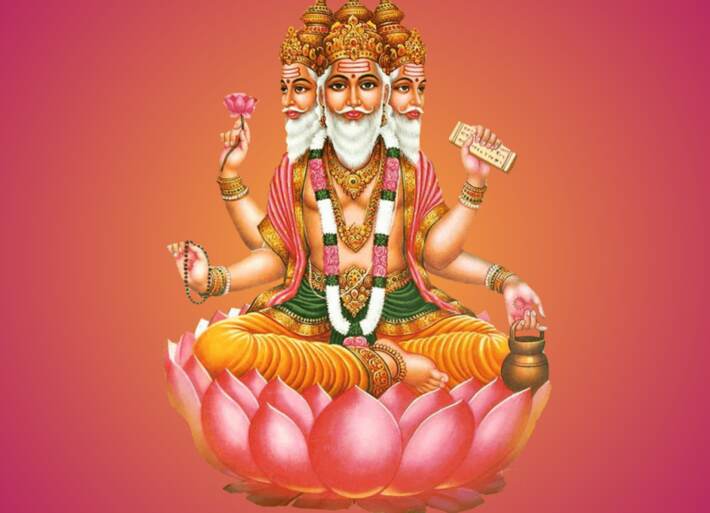Who is Lord Brahma?
Lord Brahma, one of the principal deities in Hinduism, is revered as the creator of the universe. As a member of the holy trinity or Trimurti, Brahma’s role complements that of Vishnu, the preserver, and Shiva, the destroyer. This divine triad maintains the cosmic balance, guiding the cycle of creation, preservation, and destruction.
Early Myths and Origins of Lord Brahma
In Hindu cosmology, the creator of the universe is said to have emerged from a lotus springing from the navel of Vishnu. This symbolic representation underscores the interconnectedness of creation and preservation. Brahma’s origin stories vary across texts, but a common theme is his emergence from a golden egg, symbolizing the birth of the cosmos.
Depictions and Iconography
Lord Brahma is traditionally depicted with four heads, each reciting one of the four Vedas, and four arms holding symbolic objects: a lotus, a scepter, a book, and a rosary. His vehicle (vahana) is the swan, Hamsa, representing wisdom and discernment.
Significance and Worship
Despite his paramount role in creation, Lord Brahma’s worship is relatively limited compared to Vishnu and Shiva. Temples dedicated to Brahma are rare, with the most famous one located in Pushkar, Rajasthan. This scarcity is often attributed to various myths explaining why Brahma is not widely worshipped, including a curse from Shiva.
Table of Features of Lord Brahma
| Role in Hinduism | Creator of the Universe |
| Part of Trimurti | Yes, along with Vishnu (Preserver) and Shiva (Destroyer) |
| Origins | Born from a golden egg or a lotus emerging from Vishnu’s navel |
| Depiction | Four faces, four arms |
| Attributes | – Four Faces: Represents omnipresence and creation of the four Vedas |
| – Four Arms: | |
| – Water Pot (Kamandalu): Symbolizes the cosmic waters | |
| – Rosary (Mala): Represents time and the cyclic nature of the universe | |
| – Book (Vedas): Represents knowledge and wisdom | |
| – Lotus: Denotes purity and creation | |
| Primary Symbols | Vedas, Kamandalu, Rosary, Lotus |
| Cosmic Function | Creation of all living beings and the physical world |
| Manu and Shatarupa | First man and woman created by Brahma |
| Day and Night (Kalpa) | A day of Brahma (Kalpa) spans 4.32 billion human years, with an equally long night |
| Major Temples | Brahma Temple in Pushkar, Rajasthan |
| Mythological Curse | Cursed by Shiva for deceit, resulting in fewer temples dedicated to him |
| Festivals | Pushkar Fair |
| Philosophical Significance | Represents the transient nature of creation and the importance of knowledge and wisdom |
| Texts and Scriptures | Vedas (Rigveda, Samaveda, Yajurveda, Atharvaveda) |
| Worship | Less commonly worshipped compared to Vishnu and Shiva |
| Symbolic Representation | Emphasizes the foundation of learning and the cyclic nature of the universe |
Questions and Answers
Q: Why is Lord Brahma not widely worshipped despite his significant role in creation?
A: Various myths explain the limited worship of Brahma. One prominent story involves a curse from Shiva, stating that Brahma would not be widely worshipped because of his role in certain cosmic disputes and perceived arrogance.
Q: What are the symbolic meanings of the objects Brahma holds?
A: The objects held by Brahma have deep symbolic meanings:
- Lotus: Represents purity and the unfolding of creation.
- Book: Symbolizes knowledge and the Vedas.
- Rosary: Signifies time and the cyclic nature of existence.
- Scepter: Denotes power and authority in creation.
Q: What is the significance of the swan (Hamsa) in Brahma’s iconography?
A: The swan, Hamsa, symbolizes wisdom, grace, and the ability to discern good from evil. It reflects Brahma’s role in the creation and the maintenance of wisdom and knowledge in the universe.
Q: Where can one find the most famous temple dedicated to Lord Brahma?
A: The most famous temple dedicated to Lord Brahma is located in Pushkar, Rajasthan. It is one of the few temples where Brahma is the primary deity and attracts numerous pilgrims and tourists.
Q: How is Brahma connected to the Vedas?
A: Each of Brahma’s four heads is said to recite one of the four Vedas, which are the foundational texts of Hinduism. This association underscores his embodiment of knowledge and the creation of sacred texts.
Q: What is the Trimurti, and what is Brahma’s role in it?
A: The Trimurti is a concept in Hinduism consisting of three gods responsible for the creation, preservation, and destruction of the universe. Brahma’s role is that of the creator, Vishnu is the preserver, and Shiva is the destroyer, together maintaining the balance of the cosmos.
The below article has tons of brahma wallpapers in HD and 4K. We’ve created a pin for you. Explore them here.
Read BBC article on Lord Brahma
Read more of such content in CelebGen


0 Comments